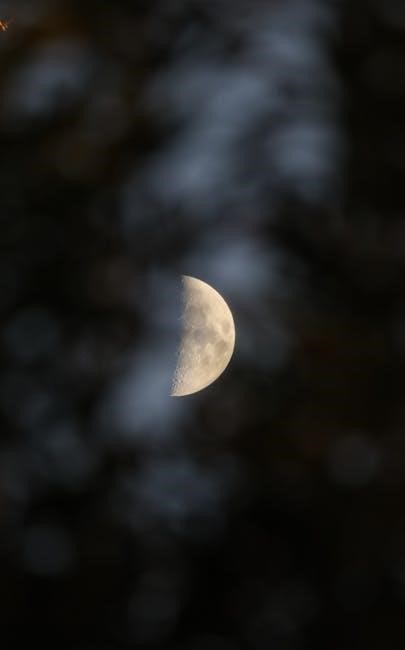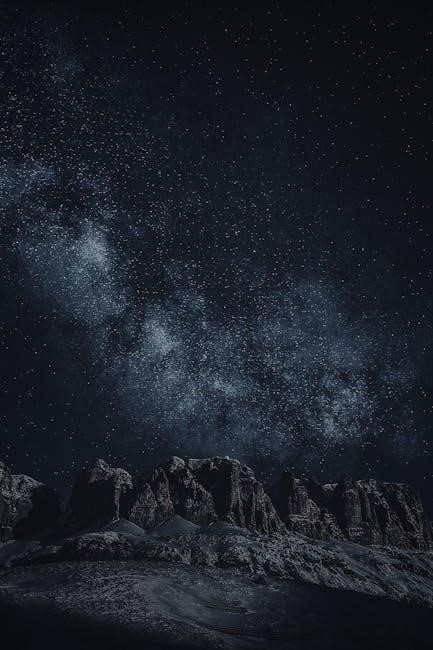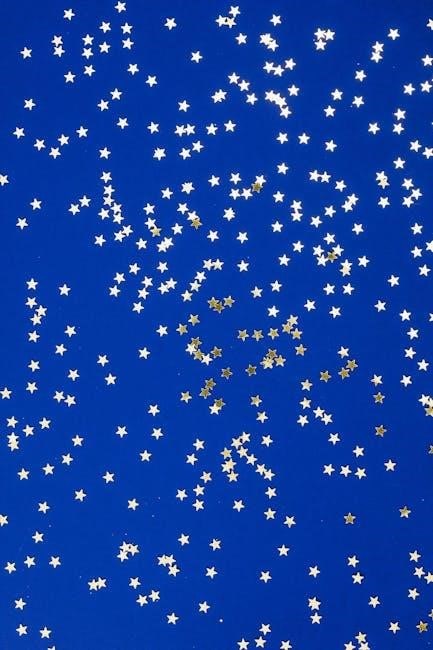The Hitchhiker’s Guide to the Galaxy First Edition: A Comprehensive Guide
Embark on a journey to explore the rare first edition. Discover key identifiers‚ dust jacket nuances‚ and market values of the sought-after science fiction book. The Hitchhiker’s Guide to the Galaxy invites you on an intergalactic adventure!
Overview of the First Edition
The first edition of Douglas Adams’s The Hitchhiker’s Guide to the Galaxy holds a special place in literary history and within the hearts of science fiction fans. Published by Pan Books‚ the initial print run is surprisingly scarce today‚ often found in well-loved and read condition. Identifying a true first edition requires close examination.
Key identifiers include the publisher’s imprint‚ the date of publication‚ and specific characteristics of the cover and dust jacket. The presence of the “Capricorn One” advertisement on the rear panel of the dust jacket is a crucial marker for the earliest issues; This first book in the series launched Adams’s career and established the hilarious‚ thought-provoking universe that continues to captivate readers and listeners.
The narrative‚ born from a successful BBC radio comedy‚ follows the hapless Arthur Dent on his interstellar adventures. The first edition represents the genesis of this iconic series‚ making it a highly desirable item for collectors and enthusiasts alike. Its value stems from its historical significance‚ rarity‚ and the enduring appeal of Adams’s unique brand of humor.
Identifying a True First Edition
Pinpointing a genuine first edition of The Hitchhiker’s Guide to the Galaxy requires a meticulous approach. Begin by verifying the publisher‚ which should be Pan Books for the original UK edition. The copyright page should not indicate any subsequent printings. A later printing will generally state “Second Impression”‚ “Third Impression” or similar.
Examine the publication date closely. It should align with the initial release year. The presence of a specific advertisement‚ notably the “Capricorn One” ad on the rear of the dust jacket‚ is a key indicator of an early printing. This is one of the most critical factors in identification.
Carefully inspect the typeface and layout; unauthorized reprints often exhibit subtle differences. A first edition will have a certain feel and look that is difficult to replicate perfectly. Consulting detailed bibliographies and comparing copies with known first editions are helpful strategies. Always be cautious of price-clipped dust jackets‚ as this can impact the value‚ though it doesn’t necessarily disqualify it as a first edition. Pay close attention to detail‚ and happy hunting!
Key Characteristics of the First Edition Dust Jacket
The dust jacket of a first edition of The Hitchhiker’s Guide to the Galaxy possesses unique characteristics crucial for identification. Its condition significantly impacts value‚ so inspect it carefully. The original price must be present and unclipped; a price-clipped jacket diminishes collectibility. Look for the “Capricorn One” advertisement on the rear panel‚ a hallmark of early printings.
Color fidelity is also critical; the jacket’s hues should be vibrant and consistent with known first editions. Faded or discolored jackets suggest wear or exposure. Examine the spine for sunning‚ which can reduce its appeal. The jacket should wrap the book snugly without excessive looseness or tears.
Pay attention to the texture and finish of the dust jacket. First editions typically exhibit a specific gloss or matte finish that is difficult to replicate perfectly. Any inconsistencies or signs of restoration should raise red flags. Check for any printing errors or variations in the jacket design‚ which may indicate a later printing or a counterfeit. The dust jacket is a critical piece of evidence.
Rarity and Collectibility Factors
The first edition’s rarity stems from limited initial print runs and the book’s immense popularity‚ which led to many copies being heavily read and subsequently damaged. Finding a copy in excellent condition is increasingly difficult‚ elevating its collectibility. Signed copies‚ especially those signed by Douglas Adams‚ are exceedingly rare and highly prized by collectors.
The presence of the original dust jacket significantly impacts value‚ particularly if it’s well-preserved and features key characteristics like the “Capricorn One” advertisement. Copies with provenance‚ such as those owned by notable figures or accompanied by letters or ephemera‚ further enhance their desirability. First editions that have been well kept are more valuable.
First editions that are free from inscriptions or markings are more desirable than those with previous owner’s names or bookplates. The overall condition‚ including the spine‚ binding‚ and pages‚ plays a crucial role in determining its collectibility. Collectors seek copies that show minimal signs of wear and aging‚ as these are the rarest and most valuable.
Price Variations and Market Value
The market value of a first edition of “The Hitchhiker’s Guide to the Galaxy” fluctuates significantly based on several factors. Condition is paramount; a pristine copy with an intact dust jacket commands a premium price. Signed copies‚ particularly those with a dedication from Douglas Adams‚ can fetch substantially higher amounts.
Rarity also plays a crucial role; first editions with specific characteristics‚ such as the “Capricorn One” advertisement on the dust jacket‚ are more sought after. The book’s provenance‚ including its history of ownership and any associated ephemera‚ can further influence its value. Market trends and collector demand also contribute to price variations.
Online marketplaces like eBay and Abebooks provide insights into current market prices‚ though these can vary widely depending on the seller and the specific condition of the book. Auction houses specializing in rare books often feature first editions‚ offering another avenue for determining market value. Professional appraisals from rare book experts provide the most accurate valuations.
Notable Advertisements in Early Editions
Early editions of “The Hitchhiker’s Guide to the Galaxy” often contained advertisements that provide a fascinating glimpse into the cultural and commercial landscape of the time. One particularly notable advertisement found in some first editions is for the film “Capricorn One.” This ad appears on the rear panel of the dust jacket and has become a key identifier for collectors.
The presence of the “Capricorn One” advertisement indicates an earlier printing within the first edition run. Its inclusion reflects the marketing strategies employed by publishers to cross-promote related media and capture the attention of potential readers. Such advertisements are now considered valuable historical artifacts‚ offering insights into the publishing industry and popular culture of the late 1970s.
Collectors often seek out copies with this specific advertisement‚ as it adds to the book’s rarity and historical significance. The advertisement’s condition is also a factor; a well-preserved dust jacket with a clear and undamaged “Capricorn One” ad enhances the book’s overall value and appeal. These small details contribute to the unique charm of early editions.
The Author’s Involvement and Editions

Douglas Adams’s direct involvement significantly shaped the evolution of “The Hitchhiker’s Guide to the Galaxy” across its various editions. His creative input extended beyond the original novel‚ influencing radio adaptations‚ stage productions‚ and later iterations of the Guide itself. Adams meticulously crafted the narrative‚ injecting his signature wit and philosophical musings into every aspect of the story.

Even after his death‚ Adams’s legacy continued to influence the series. He played a part in post-humous works and adaptations. The “Hitchhiker’s Guide to the Galaxy Mk II‚” featured in later radio series episodes‚ showcased his conceptual ideas. Kevin Davies‚ involved in the original stage productions‚ contributed designs and elements to these expanded editions‚ ensuring the author’s vision remained intact.
Collectors often value editions that reflect Adams’s direct participation‚ such as those containing his notes‚ forewords‚ or unique contributions. The evolution of the Guide‚ reflecting Adams’s ever-expanding universe‚ remains a focal point for enthusiasts seeking a deeper connection to the author’s creative genius. His influence permeates every edition.
Adaptations and Expanded Universe Editions
The immense popularity of “The Hitchhiker’s Guide to the Galaxy” has spawned numerous adaptations and expansions beyond the original book. These include radio series‚ stage plays‚ comic book adaptations‚ and even a feature film. Each adaptation offers a unique interpretation of Adams’s work‚ expanding the universe and introducing new audiences to the story.
Comic book versions‚ such as those published by DC Comics‚ visually interpret the narrative‚ offering a different perspective on the characters and settings. Radio dramatizations further enriched the story with sound effects and voice acting‚ bringing the Hitchhiker’s universe to life. Stage adaptations provided a theatrical experience.
Expanded universe editions often incorporate elements from these various adaptations‚ creating a complex and interconnected web of stories. These editions may include additional content‚ such as new characters‚ storylines‚ or perspectives on existing events. The adaptations ensure the story lives on‚ and expands. The expanded universe provides more of the galaxy to explore.
The Hitchhiker’s Guide to the Galaxy Mark II
The Hitchhiker’s Guide to the Galaxy Mark II represents a later iteration of the titular guide within the expanded universe. It’s described as behaving in a more mysterious‚ sinister‚ and airborne manner compared to the original. This version played a significant role in later stories‚ offering updated information and a more interactive experience for its users.

In the radio series‚ Professor Stephen Hawking even voiced the Mark II‚ introducing himself as the updated guide. This highlights the Mark II’s significance and the evolving nature of the Hitchhiker’s universe. The Mark II featured the first appearance of the 42 Puzzle‚ designed by Adams himself.
This updated version of the guide reflects the ever-changing galaxy and the need for information to adapt to new discoveries and threats. The Mark II shows how the galaxy is evolving over time‚ bringing new possibilities to the universe. The Mark II represents technological advancement. The original guide is classic‚ but outdated.
Condition and Preservation of First Editions
The condition of a first edition significantly impacts its value and collectibility. Many first editions of “The Hitchhiker’s Guide to the Galaxy” are described as “read to death‚” indicating the importance of finding copies in good condition. Collectors should look for copies with clean pages‚ tight bindings‚ and no marks or inscriptions.

The dust jacket plays a crucial role in preserving the book’s condition. An intact dust jacket‚ free from tears‚ fading‚ or price clipping‚ greatly enhances the book’s value. Proper storage is essential to prevent damage from sunlight‚ moisture‚ and pests. Archival-quality sleeves can protect the dust jacket from wear and tear.
Handling first editions with care is paramount. Avoid bending the spine‚ marking the pages‚ or exposing the book to extreme temperatures. Regular inspection for signs of deterioration can help identify potential problems early on. Professional restoration may be considered for severely damaged copies‚ though this can affect value.
